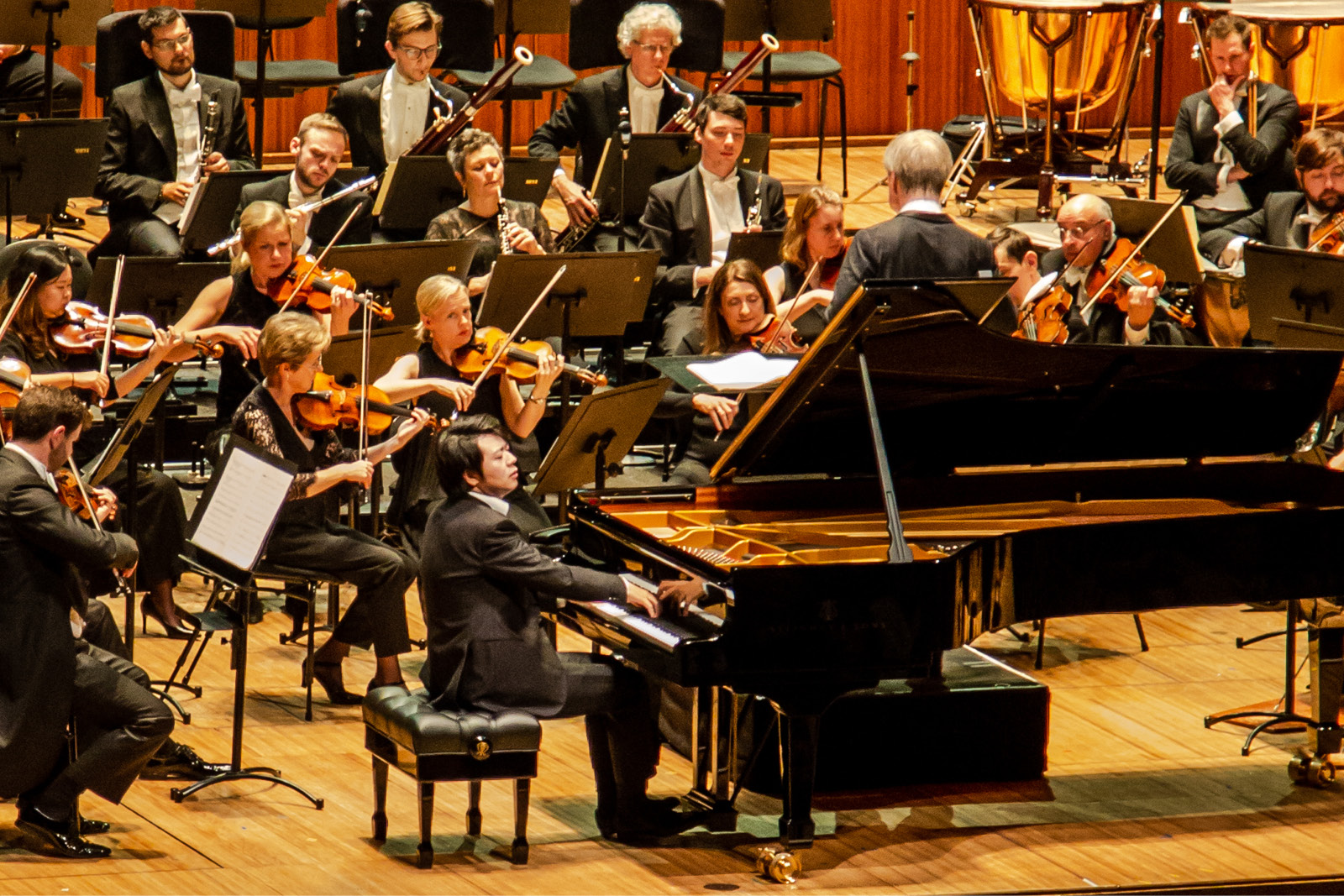When Chinese superstar pianist Lang Lang last stormed the stage of the Sydney Opera House in 2016, Limelight’s Clive Paget described his opening bars of the Grieg Piano Concerto as “crashing in with power and passion.” We saw a different side of Lang Lang, however, in his thoughtful, almost meditative solo entry to Mozart’s Piano Concerto No 24, K.491, with the Sydney Symphony Orchestra, the pianist finding a stillness to contrast the animated reading David Robertson gave the opening tutti.
 Lang Lang, David Robertson and the Sydney Symphony Orchestra. Photo © Rae Sturm
Lang Lang, David Robertson and the Sydney Symphony Orchestra. Photo © Rae Sturm
Between Australian trips, Lang Lang suffered an injury to his left arm, which more or less put paid to public performances for over a year and it is only since last July, when he opened the Tanglewood Festival with this same Mozart Concerto (swapping out the Tchaikovsky he was scheduled to perform) that he has been back on the touring circuit. Famous for his distinctive, flamboyant – and therefore, for some, controversial – performances of Romantic repertoire, he has recently been favouring the comparatively understated Mozart C Minor Concerto (which he also performs with the Melbourne Symphony Orchestra on this trip), one of only two Minor concertos the composer wrote. Completed while Mozart was working on The Marriage of Figaro, the concerto might not boast the fireworks of Grieg, but it’s nonetheless a dark, turbulent work and for many the pinnacle of Mozart’s concerto writing – upon hearing it Beethoven commented, “we shall never be able to do anything like that!” and echoes of Mozart’s music can be heard in his own C Minor Piano Concerto.
While Lang Lang embraced the Concerto’s more sombre moods, there was still plenty of spark in his playing, which with his demonstrative hand movements is as much visual feast as aural. If the boisterous energy of some of the first movement runs jarred slightly with the reflective opening, this was a charismatic performance in which the pianist’s own ideas projected clearly, the pianist’s left hand at one point giving the accompaniment an almost jazzy lilt. Lang Lang was at his most theatrical in the cadenza, the pianist flicking off the final note of a flourish like lint off a key, his fluid hand movements above the keyboard seeming to conjure notes from the air. There were some nice subtle moments – Lang Lang’s glimmering accompaniment of the flute in the first movement, for instance, was exquisite, while he brought a spacious simplicity to the Andante’s opening. Passages in the middle of the second movement became quite beaty at times, which seemed to catch the orchestra slightly off guard, the pianist’s left foot tapping audibly on the stage, but when the opening theme returned as a hushed whisper in the recapitulation, the effect was magical. The finale opened with a bold piano entry, Lang Lang spritely in the variations – which featured some finely produced echo effects – bringing the Concerto to a flourishing close. Though the interpretation didn’t quite mesh as a whole, there were enough great individual moments to make it captivating throughout. Lang Lang treated the audience to two flashy encores, punching out the first exercise from Czerny’s The School of Velocity to cap off the night.
While Lang Lang’s star power pushed the Concerto from its traditional slot before interval to the final place on the program, Robertson and the SSO opened the evening with two very different takes on incomplete Schubert symphonies. Schubert was composing right to the end of his life, and left behind piano sketches for a symphony – not the one we now know as the Unfinished – that his death in 1828 left him unable to complete. In his 1990 work Rendering, Italian composer Luciano Berio takes these sketches and orchestrates them in the style of Schubert, filling in any gaps with nebulous music coloured by celeste, and veined with references to Schubert’s other late works. While Berio’s title suggests plastering the gaps in a wall to create a smooth surface, the effect – thanks particularly to the glittering celeste – is more akin to the Japanese art of Kintsugi, in which broken pottery is repaired with gold joinery, making a feature of the space between shards.
Robertson leaned into the romance and drama of the ‘Schubert’ sections, as they emerged from and receded back into the febrile sound of Berio’s music, as if Schubert were drifting in and out of delirium. The oboe and bassoon duet in the incredibly atmospheric second movement was a particular highlight, as was Schubert’s foray into counterpoint in the finale, the lines dispatched with clarity by Robertson and the SSO.
Berio’s work was a fascinating introduction to what we know ‘officially’ as the Unfinished Symphony (unfinished because Schubert abandoned it for whatever reason in 1822), with its famous opening – rendered here by the SSO’s velvet lower strings and scurrying violins – and Robertson savouring the delicacy of the lighter second theme. Here the strings were in fine form, with some wonderfully hushed cello passages and a crescendo that grew organically from the basses to encompass the entire orchestra. While there were some clarity issues in the winds in the first movement, guesting clarinettist Giovanni Punzi (Principal at the Copenhagen Philharmonic Orchestra) delivered a subtle, smooth-edged solo in the second. Placing the Unfinished alongside Berio’s Rendering offered an opportunity to view the well-worn classic from a new angle, proving once again that – with smart programming – popular doesn’t have to mean light on substance.
Lang Lang performs again with the Sydney Symphony Orchestra on June 29











Comments
Log in to join the conversation.